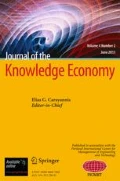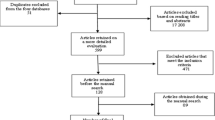Abstract
Knowledge and creativity have always played a key role in the economy. Since the 2000s, the relevance of the creative industries, a high-growth sector, has been pointed out as long as its strong and positive effects on jobs and economic growth. In the current context of rapid globalization and technological development, the innovation system is getting even more complex because it implies a shift in research focus from the supply to the demand side environment (consumption-driven economy). The authors focus on theoretical approaches coming from management and media studies able to explain the current paradigm shift in innovation and knowledge production and use: the Triple Helix model (and its developments) and the systems theory. As an interesting case study, the Creative Enterprise Australia is analysed according to the theoretical approaches shown. The paper tries to shed new light on the evolving role of knowledge pointing out the overlapping relationships between all actors involved, the interpenetration of systems and the prominent appointment of the media as an interpretative framework of the convergence of the depicted theories.
Similar content being viewed by others
Notes
The “public” system is a concept mainly developed by Görke and Kohring and Hug [12, 19], stating that the public provides a synchronization function by perceiving every other system from an external point of view, confronting them with the result of its perceptions. Journalism, as the dominant subsystem of the public, observes other systems such as the scientific system and provides to every other system “new, surprising, unexpected and often creative opportunities for follow-up communication within the system” [13].
Science journalism particularly and the journalistic construction or mediation of science become much more relevant in a society where knowledge and creativity play a central role.
References
Afonso O, Monteiro S, Thompson M (2010) A growth model for the Quadruple Helix Innovation Theory. NIPE WP 12/2010. Resource document: http://www3.eeg.uminho.pt/economia/nipe/docs/2010/NIPE_WP_12_2010.pdf. Accessed 1 Nov 2010
Bathelt H, Hecht A (2008) Key technology industries in the Waterloo Region: Canada's Technology Triangle (CTT). Can Geogr 34(3):225–234
Bockelmann J (2011) Wissenschaftsberichterstattung im Spiegel. Eine Inhaltsanalyse im Zeitverlauf. In: Ruhrmann G, Milde J, Zillich AF (eds) Molekulare Medizin und Medien. VS Verlag für Sozialwissenschaften, Wiesbaden
Carayannis EG, Campbell DF (eds) (2006) Knowledge creation, diffusion, and use in innovation networks and knowledge clusters. A comparative systems approach across the United States, Europe, and Asia. Praeger, Westport
Carayannis EG, Campbell DF (2009) Knowledge creation, diffusion, and use in innovation networks and knowledge clusters. A comparative systems approach across the United States, Europe, and Asia. Praeger Publishers, London
Colapinto C (2007) Venture capital district: from Silicon Valley and Route 128 to Waterloo Region Technology. Int Rev Econ 54(3):319–343
Colapinto C (2011) Exploring academic entrepreneurship in the Milan area. Ind High Educ 25(1):1–7
Creative Enterprise Australia, http://www.creativeenterprise.com.au. Accessed 29 Sep 2010
Cunningham SD, Cutler TA, Ryan MD, Hearn GN, Keane MA (2003) Research and Innovation Systems in the Production of Digital Content and Applications. Content and Applications, Creative Industries Cluster Study Volume III. Commonwealth of Australia (DCITA) Canberra
Etzkowitz H, Leydesdorff L (2000) The dynamic of innovation: from National System and “Mode 2” to a Triple Helix of university-industry-government relations. Res Policy 29:109–123
Etzkowitz H, Zhou C (2007) The entrepreneurial University in Various Triple Helix Models. Singapore Triple Helix VI Conference Theme Paper
Görke A (1999) Risikojournalismus und Risikogesellschaft. Sondierung und Theorieentwurf. Westdeutscher Verlag, Opladen
Görke A, Scholl A (2006) Niklas Luhmann's Theory of Social Systems and Journalism Research. Journal Stud 7(4):644–655
Khan MR, Al-Ansari M (2005) Sustainable innovation as a corporate strategy. Intellectual assets management, Saudi Arabia. Resource document: http://www.triz-journal.com/archives/2005/01/02.pdf. Accessed 29 Sep 2010
Kim K-W (2003) Die Entwicklung der Wissenschaft in einem Schwellenland. Deutscher Universitätsverlag, Wiesbaden
Kohring M (1997) Die Funktion des Wissenschaftsjournalismus. Ein systemtheortischer Entwurf. Westdeutscher Verlag, Opladen
Kohring M (2005) Wissenschaftsjournalismus. In: Weischenberg S, Kleinsteuber HJ, Pörksen B (eds) Handbuch Medien und Journalismus. UVK, Konstanz, 485–488
Kohring M, Görke A (2000) Genetic engineering in the international media: an analysis of opinion-leading magazines. New Genet and Soc 19(3):347–365
Kohring M, Hug DM (1997) Öffentlichkeit und Journalismus. Zur Notwendigkeit der Beobachtung gesellschaftlicher Interdependenz – Ein systemtheoretischer Entwurf. Medien J 1(1997):15–33
Kohring M, Matthes J (2002) The Face of Btiotech in the nineties: how the German press framed modern biotechnology. Public Underst Sci 11(2):143–154
Leydesdorff L (2006) The knowledge based economy. Upublish.com. Accessed 29 Sep 2010
Lucas RE (1988) On the mechanics of economic development. J Monetary Econ 22(1):3–42
Luhmann N (1988) Soziale Systeme. Grundriss einer allgemeinen Theorie. Frankfurt a. M.: Suhrkamp
Palmer AW (1993) News from the Rain Forest: Niklas Luhmann and the social integration of environmental communication. Public Underst Sci 2(1):157–187
Peters HP, Heinrichs H, Jung A, Kallfall M, Petersen I (2008) Medialization of science as a prerequisite of its legitimization and political relevance. In: Cheng D et al (eds) Communicating science in social contexts. New models, new practices. Springer, Amsterdam
Romer PM (1986) Increasing returns and long-run growth. J Political Econ 94:1002–1037
Romer PM (1990) Endogenous technological change. J Political Econ 98(5):S71–S102
Saxenian A (1996) Regional advantage, culture and competition in Silicon Valley and Route 128. Harvard University Press, Cambridge
Schäfer MS (2007) Wissenschaft in den Medien. VS Verlag für Sozialwissenschaften, Wiesbaden
Scholl A, Weischenberg S (1998) Journalismus in der Gesellschaft. VS Verlag für Sozialwissenschaften, Wiesbaden
The Work Foundation, NESTA (2007) Staying ahead: the economic performance of the UK's creative industries. Resource document: http://workfoundation.net/research/publications/publicationdetail.aspx?oItemId=176. Accessed 29 Sep 2010
Van Wissel C (2007) Hochschule als Organisationsproblem. Neue Modi universitärer Selbstbeschreibung in Deutschland. Transcript Verlag, Bielefeld
Willke H (1996) Systemtheorie II: Grundzüge einer Theorie der Intervention in komplexe Systeme. UTB, Stuttgart
Author information
Authors and Affiliations
Corresponding author
Rights and permissions
About this article
Cite this article
Colapinto, C., Porlezza, C. Innovation in Creative Industries: from the Quadruple Helix Model to the Systems Theory. J Knowl Econ 3, 343–353 (2012). https://doi.org/10.1007/s13132-011-0051-x
Received:
Accepted:
Published:
Issue Date:
DOI: https://doi.org/10.1007/s13132-011-0051-x




